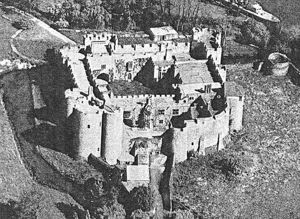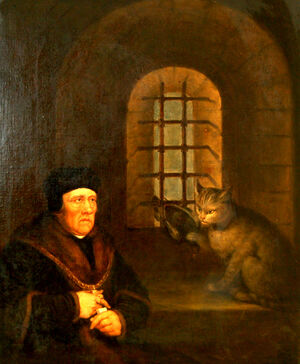Biography
| Henry Wyatt is managed by the Medieval Project. Pre-1500 certified? Join: Medieval Project Discuss: Medieval |
Sir Henry Wyatt (aka Wiat or Wiatt), soldier and financier who served the courtiers of Henry VII and Henry VIII, was born ca. 1460, the son of Richard Wyatt of Yorkshire and Margaret, daughter of William Bailif, of Reigate (Surrey).[1]
Henry was a part of an unsuccessful revolt against Richard III, for which he was imprisoned. It is said that Henry would not have survived his imprisonment without the help of a cat, who brought him pigeons to eat.
After the Battle of Bosworth Field and the death of Richard III, Henry Wyatt was freed from prison and rose to a position of prominence, including serving in the following positions:[1]
- Keeper of Norwich Castle and gaol in 1485
- Clerk of the king's jewels before September 1486
- Master of the king's jewels in July 1488 (serving until 1524) and clerk of the king's mint (resigning as treasurer of the king's chamber by 1528)
- Keeper of the change, assayer of the money and coinage and comptroller of the mint by 1494
In 1492, he purchased Allington Castle in Kent.[1][2] However, Sir Henry maintained links to Yorkshire as in 1487 he was joint bailiff and constable of Consibrough Castle; fought that year in the battle of Stoke-on-Trent; and was captured by the Scots, imprisoned, and held for ransom (for which he was reimbursed 22 August 1515).[1]
By 1502, he married Anne Skinner, daughter of John Skinner of Reigate, Surrey, and they had children.[1]
Other notable positions and events:[1]
- Privy councillor 1504
- Granted arms 1507/8
- Executor of Henry VII's will
- Granted livery in May 1509
- Made knight of the Bath at the coronation of Henry VIII and appointed to his privy council
- Commissioner of the peace for Middlesex and Surrey 1509-1515
- Accompanied the king to Calais in 1513
- Made knight-banneret after the battle of the Spurs, August 1513
- Returned to Calais with Henry VIII in 1519
- Attended Henry during the visit of Charles V in May 1522
- Sheriff of Kent before May 1522
Sir Henry Wyatt died 10 November 1536, his will directing his burial at Milton, near his wife Anne.[1]
Sources
- ↑ 1.0 1.1 1.2 1.3 1.4 1.5 1.6 1.7 1.8 1.9 Burrow, Colin. "Wyatt, Sir Thomas (c. 1503–1542), poet and ambassador" in Oxford Dictionary of National Biography. May 28, 2015. Oxford University Press. Accessed online 21 Nov 2019 at OxfordDNB.com with subsc.
- ↑ Cave-Browne, John. The History of Boxley Parish. (Maidstone: E. J. Dickinson, 1892), online at Archive.org, page 133, 137.
See also:
- Stephen, Sir Leslie, ed. Dictionary of National Biography, 1921–1922. 22 vols. (London, England: Oxford University Press, 1921–1922), online with subsc. at Ancestry.com, Vol. 21, pages 1098-1102: Thomas Wyatt (?1503-1542).
- Notes and Queries (London, England: G. Bell, 1850-). Online at Archive.org, c.1, ser 3, vol. 3 (3 Jan 1863) page 9-10: transcribed inscription of the Wiat family monument at Boxley, Kent.
It may be possible to confirm family relationships with Henry by comparing test results with other carriers of his Y-chromosome or his mother's mitochondrial DNA. Y-chromosome DNA test-takers in his direct paternal line on WikiTree:
- Fontaine Wiatt
 :
Family Tree DNA Y-DNA Test, haplogroup I-S2233, FTDNA kit #93595
:
Family Tree DNA Y-DNA Test, haplogroup I-S2233, FTDNA kit #93595 - Brad Wyatt
 :
Family Tree DNA Y-DNA Test 700 markers, haplogroup R-FTA16366, FTDNA kit #65638
:
Family Tree DNA Y-DNA Test 700 markers, haplogroup R-FTA16366, FTDNA kit #65638
Have you taken a DNA test? If so, login to add it. If not, see our friends at Ancestry DNA.
Featured National Park champion connections: Henry is 17 degrees from Theodore Roosevelt, 20 degrees from Stephanus Johannes Paulus Kruger, 16 degrees from George Catlin, 17 degrees from Marjory Douglas, 24 degrees from Sueko Embrey, 17 degrees from George Grinnell, 24 degrees from Anton Kröller, 16 degrees from Stephen Mather, 23 degrees from Kara McKean, 20 degrees from John Muir, 14 degrees from Victoria Hanover and 25 degrees from Charles Young on our single family tree. Login to find your connection.
Categories: Masters of the Jewel Office






another "source" is http://roglo.eu/roglo/
From Wikipedia, the free encyclopedia Jump to: navigation, search Portrait of Henry Wyatt by Hans Holbein the Younger.
Sir Henry Wyatt (14601537) was an English courtier. Contents
1 Early life to 1485 2 Life under the Tudors 3 Allington Castle 4 Death 5 Family 6 References
Early life to 1485
A younger son of a Yorkshire family, little is known of Henry Wyatt before he adopted the cause of Henry Tudor, later to become king Henry VII. Many myths and assumptions have been woven around his privations in prison as a supporter of the Tudor partys opposition to Richard III in the years 1483-85, and are still to be found recounted as facts. Some of them occur in the widely cited entry in the Dictionary of National Biography (c.1900, available online), s.v. Thomas Wyatt (poet), although the entry has since been modified by the 2004 Oxford Dictionary of National Biography.
The Wyatt family papers in the British Library[1] contain material which provides the nearest that can be found to an authentic account of this period of his life. Recently transcribed and published in full, the relevant documents, although collated and written up in the 18th century, incorporate a self-contained narrative about Wyatt which can be dated to the mid 17th century. At this date the family was intent on reclaiming its former status after falling into disgrace with the execution and attainder of his grandson. The aim was to play up the glory days of Henrys adherence to the Tudor cause, describing him inter alia as his Countrys martyr.[2]
It is unknown why and in what precise capacity he came to act on behalf of the exiled Tudor, or how he came to be imprisoned. He appears to have had contacts among those close to the Scots king James III and may have been an intermediary in attempts to secure Scottish support for Henry Tudors invasion. Possibly he fell into the hands of some Scottish baron with Yorkist sympathies, only to be released when Henry VII was securely on the throne, after a considerable period of cruel imprisonment, and on the promise of a huge ransom.[3]
His exploits in the Wyatt family papers include being imprisoned often, once in a cold and narrow Tower, where he would have starved but for the ministrations of a kindly cat who befriended him and brought him food. During his incarceration he suffered tortures involving the use of horse-barnacles and being force-fed mustard and vinegar. On one occasion the Tyrant himself examined him, trying unsuccessfully to persuade Wyatt to change sides. Eventually in 1485 he was released from imprisonment in Scotland and received the thanks of the newly crowned Henry VII. His first recorded grant was on 11 October 1485 when he was appointed keeper of Norwich castle and gaol.[2] A grant of Henry VIII on 22 August 1515 confirms that Wyatt still needed money to pay off his remaining Scottish ransom.[4]
In a surviving letter[5] written a few months after Wyatts death, his son Thomas wrote that God had preserved his father in prison from the handes of the tirant that could find in his hart to see him rakkid, from two yeres and more prisonment in Scotland in Irons and Stoks, and from other tribulations.
The myth that he was imprisoned in the Tower of London finds its first appearance in 1702 on a stone tablet in Boxley church erected by Edwin Wyatt, Henrys great-great-great-grandson. The claim is unlikely and finds no support in any records including those of the Tower of London authorities. Two reasons may account for the error. First, the association with Henrys son and grandson, each of whom was thrown into the Tower under the Tudors. The second lies in the letters oblique reference to being racked, which may however be figurative rather than literal. Certainly the Wyatt family papers never mention the rack, as one would have expected them to, when describing the privations he suffered.[2]
The 2004 Oxford DNB states that his support for Henry Tudor began before 1483, and that he probably participated in Buckinghams Rebellion. No evidentiary support is available for either statement. The entry continues, Family legend has it that he was imprisoned and interrogated by Richard III himself.[6] However, Richard III is never named by the Wyatt family. The assumption is derived from two instances of the word tyrant applied to Wyatts captor, a term which in the 16th century could refer to Anyone who acts in a cruel, violent, or wicked manner.[7] More likely it referred to the Scottish baron postulated by Conway (above). Records show that Richard III never set foot in Scotland during his reign.[8] Life under the Tudors
Wyatts close connections with Scotland came to the fore in his later career as Henry VIIs agent in that country,[9] for which there is ample evidence of his employment on secret and sensitive missions.[3]
He assumed high places at court,[10] being admitted to the privy council, and remained high in the royal favour. He was one of Henry VII's executors, and one of Henry VIII's guardians. He was admitted to the privy council of the new king in April 1509, and became a knight of the Bath on 23 July of the same year. In 1511 he was made jointly with Sir Thomas Boleyn constable of Norwich Castle, and on 29 July of the same year was granted an estate, Maidencote, at Estgarstone in Berkshire. At the battle of the Spurs he served in the vanguard (16 August 1513).[10] Allington Castle
He purchased in 1492 Allington Castle and its estate, near Maidstone in Kent, and made the place his principal residence. Henry VIII visited him there in 1527 to meet Wolsey on his return from the continent. Wyatt remained on good terms with Sir Thomas Boleyn, who resided at Hever Castle.[10] The proximity (about 20 miles) accounts for the meeting in a family setting of Sir Henry's poet son Thomas, and Sir Thomas's daughter Anne, the future queen, and the poetry in the courtly love tradition that resulted.[11] Death
Wyatt died on 10 November 1537, and, in accordance with the directions in his will, was buried at Milton, near Gravesend.[10] Family
He was the father of:
Sir Thomas Wyatt Margaret Wyatt
References
^ BL Add MSS 62135-62138, sections 62135 (2 vols), vol 2, ff. 359-369 and 456. ^ a b c Annette Carson, The Questionable Legend of Henry Wyatt, Ricardian Register (Richard III Society, Inc.), Vol. 42 No. 3, September 2011, pp.2-8; http://www.richardiii-nsw.org.au/?p=6088 ^ a b Agnes Conway, Henry VIIs Relations with Scotland and Ireland, 14851498 (Cambridge, 1932), pp.7-8. ^ Letters & Papers, Henry VIII, vol 2, 1515-18 (1864) pp. 227-388. ^ BL Add 32379, BL Egerton 2711. ^ Colin Burrow, Oxford Dictionary of National Biography (Oxford, 2004) Vol. 60, s.v. Thomas Wyatt ^ Shorter Oxford English Dictionary on Historical Principles (OUP, 1980) ^ Rhoda Edwards, The Itinerary of Richard III 1483-1485 (Richard III Society, 1983, 1995) ^ S. B. Chrimes, Henry VII (1984), p. 87 note 4. ^ a b c d "Wyatt, Thomas (1503?-1542)". Dictionary of National Biography. London: Smith, Elder & Co. 18851900. ^ Eric Ives, The Life and Death of Anne Boleyn (2005), pp.6774.
Attribution